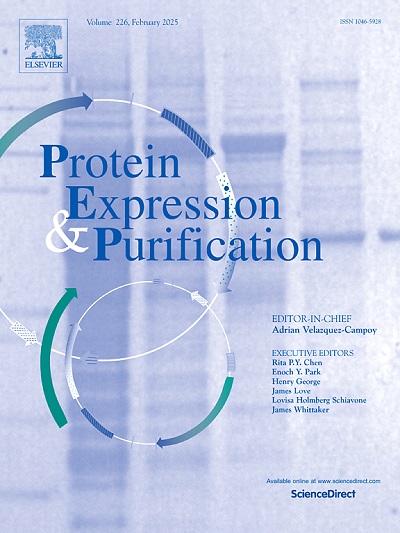Optimization of expression and renaturation methods for the production of a recombinant fibrinolytic protease showing in vivo antithrombotic activity
IF 1.2
4区 生物学
Q4 BIOCHEMICAL RESEARCH METHODS
引用次数: 0
Abstract
Bacterial fibrinolytic enzymes are promising in treating thrombosis-associated cardiovascular disease. The recombinant fibrinolytic enzymes exhibiting enhanced specificity and improved pharmacokinetics, being less immunogenic and easy to produce, can be advantageous over wild-type enzymes. However, efficient expression and refolding of recombinant enzymes is a significant challenge; therefore, three different analytical methods were compared in this study for the efficient expression and refolding of a recombinant fibrinolytic protease. The gene sequence encoding for fibrinolytic enzyme derived from Bacillus subtilis was codon-optimized according to Escherichia coli codon preference, and this gene was synthetically cloned into the pET26b(+) vector. Alignment of amino acid sequence of this protease gene revealed high sequence similarity with other species of the genus Bacillus. 24 h induced expression at 37 °C and dialysis for renaturation was the most suitable process for expression (enzyme yield) and refolding or renaturation of a ∼40 kDa recombinant α-fibrinogenase enzyme produced in the E. coli (DE3) strain. The recombinant protein demonstrated in vitro fibrinolytic, anticoagulant, thrombin-inhibition, and thrombolytic activities but did not show fibrinogenolytic or in vitro cytotoxicity activity. At a dose of 4 mg/kg, it was found to be non-toxic to Wistar strain albino rats post 72 h of injection but demonstrated dose-dependent in vivo anticoagulant activity.

优化表达和再生方法的生产重组纤溶蛋白酶显示体内抗血栓活性
细菌纤维蛋白溶解酶在治疗血栓相关心血管疾病方面很有前景。重组纤溶酶具有增强的特异性和改善的药代动力学,免疫原性较低,易于生产,比野生型酶具有优势。然而,重组酶的高效表达和重折叠是一个重大挑战;因此,本研究比较了三种不同的分析方法对重组纤溶蛋白酶的高效表达和重折叠。根据大肠杆菌密码子偏好对枯草芽孢杆菌纤维蛋白溶酶基因序列进行密码子优化,并将该基因合成克隆到pET26b(+)载体中。在大肠杆菌(DE3)菌株中产生的重组α-纤维蛋白原酶在37°C下诱导表达24 h并透析恢复是最合适的表达(酶产率)和重折叠或恢复的过程。重组蛋白在体外表现出纤维蛋白溶解、抗凝血、凝血酶抑制和溶栓活性,但不表现出纤维蛋白原溶解或体外细胞毒性活性。在4 mg/kg的剂量下,注射72 h后对Wistar白化大鼠无毒,但显示出剂量依赖性的体内抗凝血活性。
本文章由计算机程序翻译,如有差异,请以英文原文为准。
求助全文
约1分钟内获得全文
求助全文
来源期刊

Protein expression and purification
生物-生化研究方法
CiteScore
3.70
自引率
6.20%
发文量
120
审稿时长
32 days
期刊介绍:
Protein Expression and Purification is an international journal providing a forum for the dissemination of new information on protein expression, extraction, purification, characterization, and/or applications using conventional biochemical and/or modern molecular biological approaches and methods, which are of broad interest to the field. The journal does not typically publish repetitive examples of protein expression and purification involving standard, well-established, methods. However, exceptions might include studies on important and/or difficult to express and/or purify proteins and/or studies that include extensive protein characterization, which provide new, previously unpublished information.
 求助内容:
求助内容: 应助结果提醒方式:
应助结果提醒方式:


